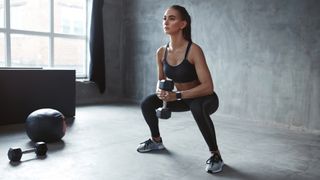ActiveWorkoutsI did 50 squats a day for a month – the results were surprisingI challenged myself to do more squats for a month – here’s how it went and what were the resultsWhen you purchase through links on our site, we may earn an affiliate commission.Here’s how it works.
ActiveWorkoutsI did 50 squats a day for a month – the results were surprisingI challenged myself to do more squats for a month – here’s how it went and what were the resultsWhen you purchase through links on our site, we may earn an affiliate commission.Here’s how it works.
I challenged myself to do more squats for a month – here’s how it went and what were the results
When you purchase through links on our site, we may earn an affiliate commission.Here’s how it works.
(Image credit: Shutterstock)

(Image credit: Shutterstock)
Jump to category:BenefitsHow toHow it went
Jump to category:BenefitsHow toHow it went
One of the best bodyweight moves you can do to strengthen your lower body is the humble squat, whether you’re looking to improve your running performance, up your lifting game, or get the bubble butt of your dreams without paying a surgeon for a Brazilian Butt Lift.
I’ve always loved squats for their effectiveness and versatility, and generally do three sets of 12-15 reps three times a week to give my legs and glutes enough time to recover between training sessions. But would I notice the difference if I upped my squatting regime to 50 reps a day for 30 days straight? I decided to find out.
[First published in January 2023]
What are the benefits of squats?
Thebest bodyweight exercises, such aspull-ups,push-upsand lunges, provide all the resistance you need to train and use more muscles at any one time to help you burn more calories, build pure strength, gain unbelievable fitness and increase your chances of achieving your weight-loss and shape-up goals in the year ahead.
Squats are acompound exercisethat helps us perform a variety of everyday movements, from picking up our shopping and children off the floor to sitting down and standing back up again. As such, they’re one of the main movement patterns humans perform, so we must maintain our squatting ability to live life fully, especially as we get older.
Squats help strengthen the joints, muscles, ligaments and tendons surrounding the hips, knees and ankles, facilitating activities such as walking, running, cycling, and jumping. But the benefits of squats don’t end there. They also help strengthen your core, reduce the risk of injury and falls, boost your athletic performance, improve muscular endurance, and torch calories and fat because they recruit the body’s biggest muscles. Best of all, they can be done anytime, anywhere, with or without equipment.
How to do squats
You’ve been dropping squats since before you could walk, but that doesn’t mean you know how to do them correctly or, most importantly, safely. You can try many variations of squats, from single-leg squats and Bulgarian split squats to plie squats and squats with an overhead press. But for the sake of this article, we’ll keep it simple and stick to the basic squat, which is the Holy Grail of squats and the foundational move you’ll need to master before moving on to more challenging weighted versions. Here’s how to do a basic squat:
Sign up to the T3 newsletter for smarter living straight to your inbox
Get all the latest news, reviews, deals and buying guides on gorgeous tech, home and active products from the T3 experts
How it went
As a regular squatter, I was tempted to try and do 100 squats a day for a month for an extra challenge but changed my mind at the last minute when I remembered I might potentially aggravate an old MCL (medial collateral ligament) knee injury from a past skiing accident.
Therefore, I stuck with 50 squats a day, and boy, am I glad I did! Day one was a breeze, and day two wasn’t too bad, either. But then the DOMS (What’s DOMS?) kicked in on day three, and I was in trouble. In short, my lower body wasn’t used to not having a rest day, and I suddenly felt like I was on a boot camp holiday all over again - but without the nice food or someone to scream words of encouragement at me.
I quickly realised that to get through this challenge, I’d have to take my recovery strategy more seriously. This entailed performing extra-long stretching sessions after my 50 squats - paying particular attention to my hamstrings, quads, glutes and calves - plenty of Epsom salt baths, regular use of myPower Plate Foam RollerandHyperice Hypervolt GO 2 Massage Gun, and lots of gentle walks to keep my legs moving so they didn’t seize up.
(Image credit: Getty Images)

(Image credit: Getty Images)
With this continued recovery approach, I quickly progressed, and the DOMS became a thing of the past after a week. In fact, the only thing I felt as the challenge continued was stronger, lighter, firmer, and fitter. Other exercises, such as walking lunges, running and spinning, felt easier once I started adding more activity to my life on top of the squats.
While squats might traditionally be a strength exercise, doing 50 on the trot is certainly enough to raise your heart rate and get your metabolism firing to encourage fat loss. Of course, this only works if you’re following a healthy diet (which I was) because no exercise will help you shape up if you’re consuming too many calories. But squats are a great place to start!